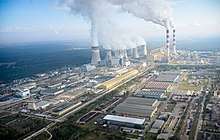Bełchatów Power Station
The Bełchatów Power Station is the world's largest (nominal power of 5,102 MW[1]) lignite-fired power station, situated near Bełchatów in Łódź Voivodeship, Poland. It is the largest thermal power station in Europe, and fifth largest fossil-fuel power station in the world.[2] It produces 27–28 TWh of electricity per year, or 20% of the total power generation in Poland. The power station is owned and operated by PGE GiEK Oddział Elektrownia Bełchatów, a subsidiary of Polska Grupa Energetyczna.
| Bełchatów Power Station | |
|---|---|
.jpg) Bełchatów Power Station | |

| |
| Official name | Elektrownia Bełchatów |
| Country | Poland |
| Location | Bełchatów, Łódź Voivodeship |
| Coordinates | 51°15′59″N 19°19′50″E |
| Status | Operational |
| Commission date | 1982 |
| Owner(s) | PGE |
| Operator(s) | PGE GiEK – Elektrownia Bełchatów |
| Thermal power station | |
| Primary fuel | Lignite |
| Power generation | |
| Units operational | 11 x 370/380 MW 1 x 858 MW |
| Nameplate capacity | 5,102 MW[1] |
| Annual net output | 27–28 TWh |
| External links | |
| Website | elbelchatow |
| Commons | Related media on Commons |
In 2011, a new 858 MW unit was commissioned and the total capacity of the power has risen to 5,053 MW.[3] The new unit has an efficiency rating of approximately 42%, which is contributing to reduction of both fuel consumption and emissions compared to the existing units.[4] The unit was built by Alstom.[2] Alstom has also carried out the modernization of the low pressure parts in all 12 turbines and, on 8 April 2009, PGE and Alstom signed a contract to modernise unit 6.[2] After modernization of other units, the total installed capacity reached 5,420 MW in September 2015.[1] In March 2017, the electrical capacity of Elektrownia Bełchatow was increased to 5,472 MW. The plant's current achievable capacity is 5,102 MW. In the second half of 2019, the achievable capacity has been reduced due to the decommissioning of the oldest unit – unit No 1.
The station's exhaust is expelled through two 300 m (980 ft) tall chimneys, among Poland's tallest free-standing structures. Coal for the plant is provided by a large neighboring strip mine.
The building of the power station itself has a height of 118 metres, a length of 740 metres and a width of 117 metres.
Carbon dioxide emissions
In 2007, the World Wide Fund for Nature ranked the power station as Europe's 11th most inefficient power station due to carbon dioxide emissions of 1.09 kg per kWh of energy produced, and the highest absolute emitter, with 30.1 million tonnes of CO2 per year.[5] In July 2009, the facility was titled as the biggest carbon polluter in the European Union by the Sandbag Climate Campaign.[6] As of 2016 it remains as the largest carbon dioxide emitter, according to European Commission data analysed by Sandbag, with annual CO2 emissions of 34.9 million tonnes.[7]
To reduce CO2 emissions, the company had planned to introduce carbon capture and storage technology. On 8 December 2008, PGE and Alstom signed a memorandum of understanding, according to which Alstom would design and construct a pilot carbon capture plant at Unit 12 by mid-2011. The larger carbon capture plant had to be integrated with the new 858 MW unit by 2015.[8] The project failed to receive a European Commission grant for €180 million allocation from the European Energy Programme for Recovery,[9][10] and was cancelled in 2013.[11]
In April 2014, the European Commission ranked Bełchatów Power Station "the most climate-damaging power plant in the European Union", with CO2 emissions of roughly 37.2 million tonnes in 2013.[12]
See also
- List of largest power stations
- List of least carbon efficient power stations
- List of coal power stations
References
- Moc osiągalna w Elektrowni Bełchatów wzrosła do 5 472 MW, retrieved 20 March 2017
- "Alstom signs a €160 million contract with PGE to modernise the Bełchatów power plant in Poland" (Press release). Alstom. 8 April 2009. Archived from the original on 30 March 2012. Retrieved 20 June 2010.
- Elektrownia Bełchatów pełną mocą, retrieved 7 August 2011
- Brück, Martin. "Cooling flue gas to maximize power plant efficiency". Power Engineering International. PennWell Corporation. Archived from the original on 25 June 2010. Retrieved 20 June 2010.
- "European dirty thirty" (PDF).
- Macalister, Terry (23 July 2009). "Meet Belcha – Europe's biggest carbon polluter (and it's about to get even bigger)". The Guardian. Guardian Media Group. Retrieved 20 June 2010.
- "NEW DATA: European coal emissions plummet by 11% in 2016". Sandbag. Sandbag. Retrieved 21 November 2017.
- "Alstom teams up with PGE Elektrownia Bełchatów to reduce CO2 output in Poland" (Press release). Alstom. 8 December 2008. Archived from the original on 30 March 2012. Retrieved 20 June 2010.
- "List of 15 energy projects for European economic recovery". European Commission. 9 December 2009. Retrieved 20 June 2010.
- "EU lines up funding for six carbon capture projects". Power Engineering International. PennWell Corporation. 7 October 2009. Retrieved 20 June 2010.
- STEFANINI, SARA. "Green Coal in the Red". Politico. Politico. Retrieved 21 November 2017.
- http://www.spiegel.de/wirtschaft/unternehmen/kohlekraftwerke-in-deutschland-stossen-mehr-co2-aus-als-im-eu-schnitt-a-962028.html
External links
| Wikimedia Commons has media related to Bełchatów power station. |

